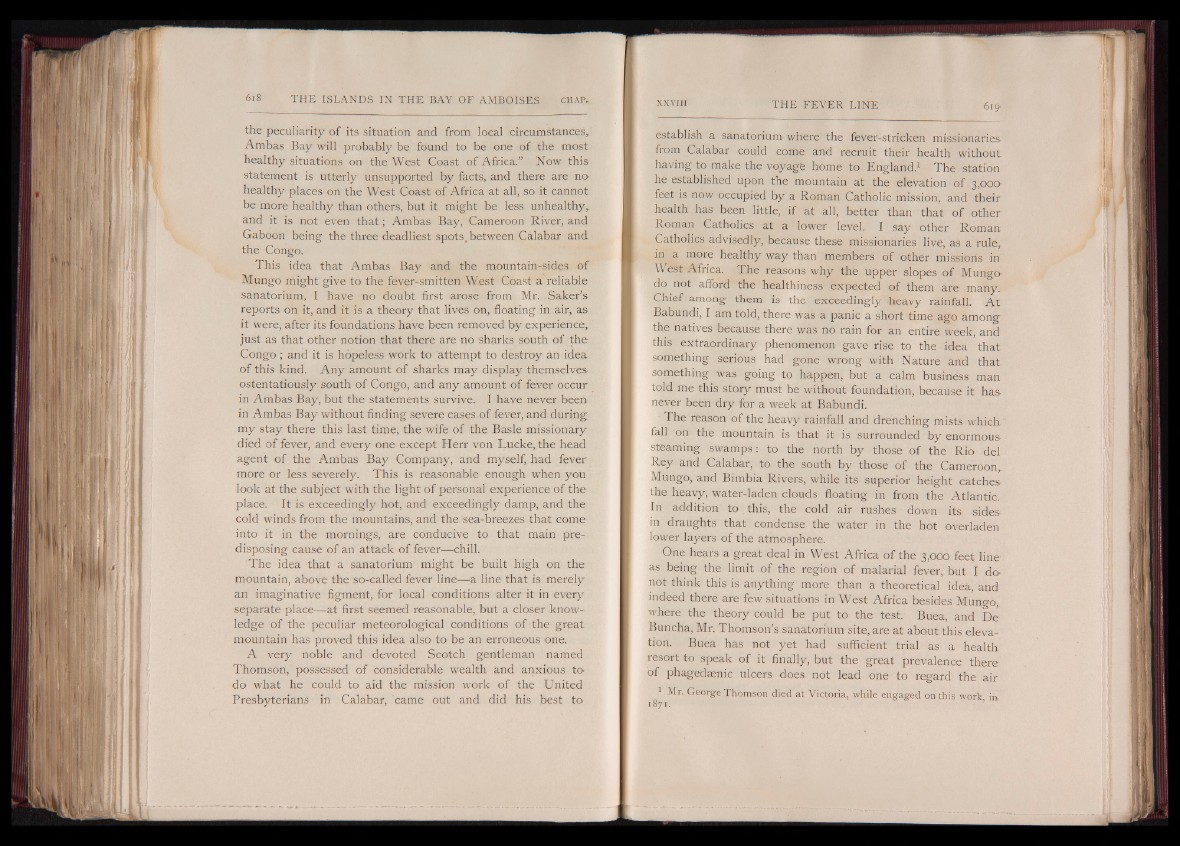
the peculiarity of its situation and from local circumstances,
Ambas Bay will probably be found to be one of the most
healthy situations on the West Coast of Africa.” Now this
statement is utterly unsupported by facts, and there are no
healthy places on the West Coast of Africa at all, so it cannot
be more healthy than others, but it might be less unhealthy,
and it is not even that; Ambas Bay, Cameroon River, and
Gaboon being the three deadliest spots, between Calabar and
the Congo.
This idea that Ambas Bay and the mountain-sides of
Mungo might give to the fever-smitten West Coast a reliable
sanatorium, I have no doubt first arose from Mr. Saker’s
reports oh it, and it is a theory that lives on, floating in air, as
it were, after its foundations have been removed by experience,
just as that other notion that there are no sharks south of the
Congo; and it is hopeless work to attempt to destroy an idea
of this kind. Any amount of sharks may display themselves
ostentatiously south of Congo, and any amount of fever occur
in Ambas Bay, but the statements survive. I have never been
in Ambas Bay without finding severe cases of fever, and during
my stay there this last tinae, the wife of the Basle missionary
died of fever, and every one except Herr von Lucke, the head
agent of the Ambas Bay Company, and myself, had fever
more or less severely. This is reasonable enough when you
look at the subject with the light of personal experience of the
place. It is exceedingly hot, and exceedingly damp, and the
cold winds from the mountains, and the sea-breezes that come
into it in the mornings, are conducive to that main predisposing
cause of an attack of fever— chill.
The idea that a sanatorium might be built high on the
mountain, above the so-called fever line— a line that is merely
an imaginative figment, for local conditions alter it in every
separate place— at first seemed reasonable, but a closer knowledge
of the peculiar meteorological conditions of the great
mountain has proved this idea also to be an erroneous one.
A very noble and devoted Scotch gentleman named
Thomson, possessed of considerable wealth and anxious to
do what he could to aid the mission work of the United
Presbyterians in Calabar, came out and did his best to
establish a sanatorium where the fever-stricken missionaries
from Calabar could come and recruit their health without
having to make the voyage home to England.1 The station
he established upon the mountain at the elevation • of 3,000-
feet is now occupied by a Roman Catholic mission, and their
health has been little, if at all, better than that of other
Roman Catholics at a lower level. I say other Roman
Catholics advisedly, because these missionaries live, as a rule,
in a more healthy way than members of other missions in
W est Africa. The reasons why the upper slopes of Mungo-
do not afford the healthiness expected of them are many.
Chief among them is the exceedingly heavy rainfall. At
Babundi, I am told, there was a panic a short time ago among
the natives because there was no rain for an entire week, and
this extraordinary phenomenon gave rise to the idea that
something serious had gone wrong with Nature and that
something was going to happen, but a calm business man
told me this story must be without foundation, because it has-
never been dry for a week at Babundi.
The reason of the heavy rainfall and drenching mists which
fall on the mountain is that it is surrounded by enormous-
steaming swamps: to the north by those of the Rio del
Rey and Calabar, to the south by those of the Cameroon,
Mungo, and Bimbia Rivers, while its- superior height catches
the heavy, water-laden clouds floating in from the Atlantic.
In addition to this, the cold air rushes down its sides
in draughts that condense the water in the hot overladen
lower layers of the atmosphere.
One hears a great deal in West Africa of the 3,000 feet line
as being the limit of the region of malarial fever, but I do-
not think this is anything more than a theoretical idea, and
indeed there are few situations in West Africa besides Mungo,
where the theory could be put to the test. Buea, and De
Buncha, Mr. Thomson’s sanatorium site, are at about this elevation.
Buea has not yet had sufficient trial as a health
resort to speak of it finally, but the great prevalence there
of phagedsenic ulcers does not lead one to regard the air
1 Mr- George Thomson died at Victoria, while engaged on this work in.
1871.